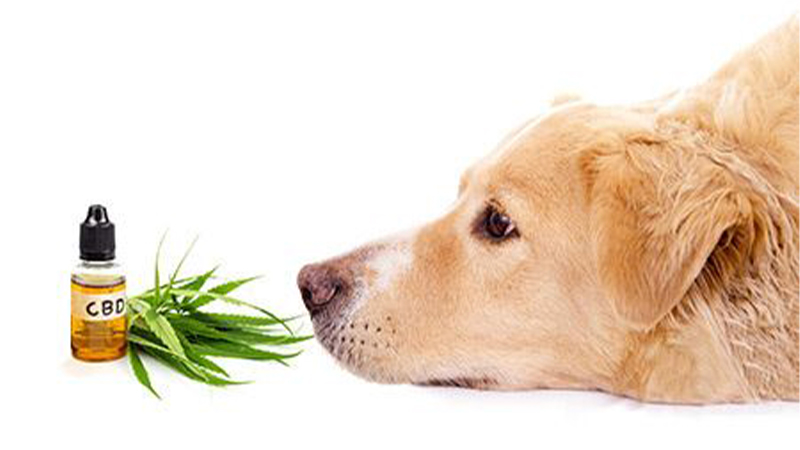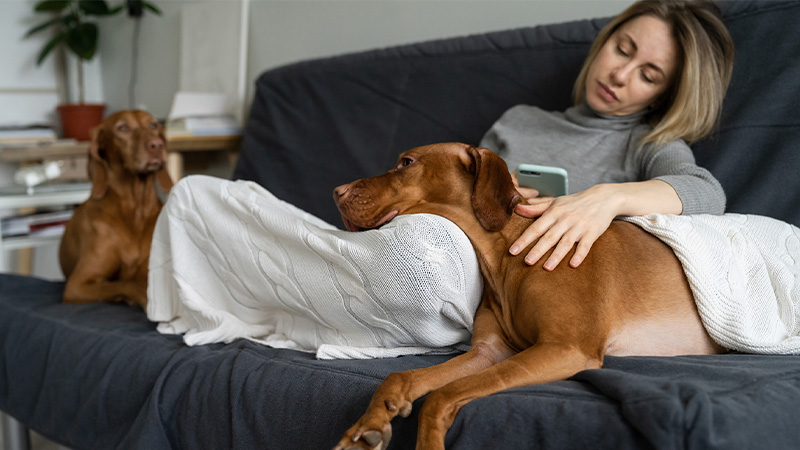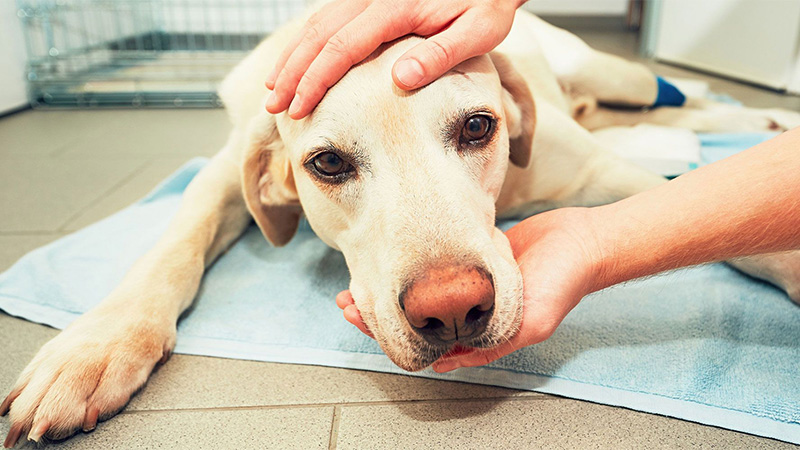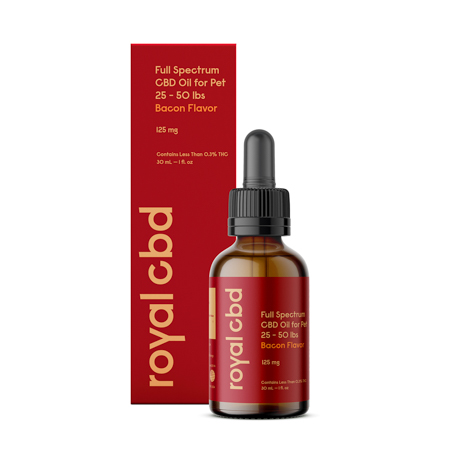What Can I Give My Dog for Anxiety?

Is your dog barking or howling every time you leave the house or when it hears disturbing noises, such as fireworks or thunderstorms?
If yes, the dog may suffer from anxiety – which is quite common among dogs these days.
There are many potential remedies you can give your dog for anxiety, from behavioral techniques to vet medications and natural anti-anxiety agents.
Dog parents want the best for their furbabies because they’re part of their families.
In this article, we’ll shed light on commonly available remedies you can give dogs to relieve anxiety.
We’ll cover both the conventional ways and holistic options, such as CBD oil.
What Can I Give My Dog for Calming Anxiety?
Dog anxiety isn’t a problem you can fix overnight. Of course, there are many potentially effective short-term solutions, but you first need to determine the root cause if you’re looking for long-term treatment.
In the next section, we elaborate on conventional anti-anxiety treatments for dogs. Keep in mind that none of the medications we mention below should be administered in the long run due to their risky safety profile.
How Is Dog Anxiety Usually Treated? (High-Risk Methods)
Conventional veterinarians usually prescribe anti-anxiety medications, such as Prozac, Paxil, Valium, Xanax, or Lorazepam.
Some vets may recommend tricyclic antidepressants or serotonin reuptake inhibitors (SSRIs).
However, since these are human medications, their doses should be adjusted to your dog’s size. Long-term use of antidepressants and anxiolytic meds isn’t recommended because it carries the risk of addiction and tolerance buildups.
Conventional medications also have a long list of potential adverse reactions, such as:
- Memory impairments
- Excessive urination
- Restlessness
- Changes in appetite
- Diarrhea, upset stomach, vomiting
- Weight gain
- Skin diseases
- Lethargy and drowsiness
- Liver toxicity
- Elevated anxiety and aggressive behavior
Let alone severe withdrawals upon the abrupt cessation of these medications.
7 Natural Remedies to Give Your Dog for Anxiety

Most conventional veterinarians forget that anxiety is usually caused by behavioral triggers. Optimizing the stress response in your dog may require rewiring its brain through a series of exercises to help them get rid of fearful associations.
There’s no magical pill that would treat anxiety for good.
Fortunately, there are a lot of safe, holistic remedies that support cognitive-behavioral therapy. These natural alternatives to conventional meds may be just as effective – not to mention they have better safety profiles.
Here’s what you can give your dog for anxiety to calm it down.
1. Herbs
You can give your dog one of the following herbs for anxiety:
- Valerian – is the most popular calming herb for anxious dogs. Veterinarians recommend it for curbing stress and inducing sedation. It works well with hyperactive or hysterical dogs, calming the nerves and promoting physical relaxation.
- St. John’s Wort – it’s a safe alternative to the aforementioned antidepressants. You can give it to your dog if it struggles with fear-based or separation anxiety.
- Chamomile – humans drink chamomile in the evening to calm down before bed. It’s a gentle sedative with relaxing properties. In higher doses, it may have a tranquilizing effect on your dog, helping it unwind and fall asleep.
2. Homeopathic Remedies
Homeopathic remedies can address specific symptoms. They’re also safe for dogs.
The most common homeopathic remedies you can give a dog with anxiety include:
- Aconite 30C
- Borax 6C
- Gelsemium 6C or 30 C
- Phosphorus 30C
- Pulsatilla Nigicans 6c or 30 C
Find out what triggers fear in your dog and use 3 of the little pellets with a blend of these ingredients. Give them to the dog with filtered water. Use a spoon to mix everything together and give your dog a few spoonfuls.
Homeopathic practitioners recommend starting with 3 doses, 12 hours apart, then stopping and monitoring the dog’s response before following through with another serving.
3. Essential Oils
Essential oils, such as pinene, eucalyptus, and lavender, contain terpenes – volatile molecules carrying a broad range of therapeutic properties.
One of the health benefits of giving essential oils to dogs with anxiety is their potential to reduce both mental and physical stress.
You can mix different essential oils to increase efficacy.
Here are a few combinations recommended by aromatherapist Joy Musacchio for different types of anxiety:
- General Anxiety: Frankincense, Roman Chamomile, Linden Blossom, Violet Leaf, Hemp Hydrosol
- Separation Anxiety: Vetiver, Lavender, Neroli, Violet Leaf, Rose Hydrosol
- Fear of Loud Noises: Hops, Frankincense, Rose Otto, Cornflower Hydrosol
For each recipe, use 5 drops of each oil and combine them with hydrosol. Then you can spray the diluted blend on your dog’s blanket, bed, or in the air. You can also use the blend in a diffuser, but remember to leave a safe exit for the dog so that it can leave the room if the aromas become too intense.
4. Bach Flower Essences
Bach flower essences were discovered by English physician Edward Bach. He found that the essence of specific flowers can provide emotional balance and reduce anxiety in dogs.
You can give this remedy to your dog because they’re mild and non-toxic, and your dog can’t overdose on them. Individual essences may address specific fears.
Combine the following essences:
- Cherry Plum
- Clematis
- Impatiens
- Rock Rose
- Star of Bethlehem
Give them to your dog in all kinds of stressful situations, such as taking it to the vet or the groomer. It can also be a viable remedy for fear of loud noises.
Bach flower essences even come in pet-specific versions that use vegetable glycerin instead of alcohol.
5. Hydrosols
Hydrosols are gentle remedies for dogs with anxiety; they’re milder than essential oils, making them a good alternative if your dog doesn’t like stronger scents.
Long story short, they’re just leftovers from essential oils, so they’re not even close to them when it comes to potency.
Use the recipe below to create an anti-anxiety hydrosol:
- ½ oz blue chamomile (Matricaria recutita)hydrosol
- ½ oz neroli (Citrus aurantium)hydrosol
- 5 drops of lavender (Lavendula angustofolia) essential oil
Pour the ingredients into a spray bottle. Shake well and spray a delicate mist on your dog. You can store it in the fridge for up to 6 months.
6. Pheromones
You can give your dog pheromone collars or use diffusers to reduce anxiety. These are synthetic hormones that work similarly to the ones produced by mother dogs to calm their children.
They curb anxiety by stimulating the olfactory system. You’ll find these products over the counter at your local pet store. Most diffusers are plugged into the wall, but some models also come in sprays. However, they’re less common than diffusers.
Calming Your Anxious Dog With CBD Oil
CBD oil is one of the most popular anti-anxiety remedies you can give your dog in times of distress.
CBD targets the endocannabinoid system (ECS), which controls all homeostatic functions in the other systems and organs.
An optimized ECS promotes stable sleep, proper stress response, a happy mood, and healthy immune function.
Aside from regulating homeostasis through the ECS signaling, CBD acts on GABA receptors and serotonin receptors, both of which are responsible for regulating the activity of the nervous system, mood, emotions, and attention.
CBD induces a calming effect on the nervous system – similar to what anxiolytic drugs aim to achieve.
But how to spot high-quality CBD oil for pups in this unregulated market?
Read this before moving on to other remedies you can give your dog for anxiety.
Best CBD Oils for Dog Anxiety
The best CBD oils for dogs with anxiety are made from organic hemp, extracted with CO2, and third-party tested for potency and purity.
If a company doesn’t meet the above standards, it’s not worth your trust.
Feeling in a rush? Below we share our best picks for high-quality CBD oils online:
1. Royal CBD
| Pros | Cons |
|
|
Royal CBD is a premium brand that offers organic CBD products for dogs and humans. The Royal CBD Paws pet oil comes in two concentrations: 250 mg and 500 mg. You can adjust the potency to the size and tolerance of your dog so that it reaps the benefits, and you don’t have to spend a fortune on a high-quality product.
These are full-spectrum extracts, so your dog receives the other cannabinoids and terpenes from hemp. These compounds contribute to the entourage effect that amplifies the therapeutic potential of CBD.
If your doggie fusses over the flavor of natural CBD oil, the bacon-flavored bottle from Royal CBD will change the game.
2. Gold Bee
| Pros | Cons |
|
|
Before transitioning to the CBD space, the team at Gold Bee had spent 10 years in the superfoods industry. That philosophy is present in the company’s line of CBD products for dogs.
Gold Bee makes CBD oils and the best CBD dog treats for anxiety. All of its products come from organic hemp and are extracted with supercritical CO2. You can look into the batch-specific certificates of analysis to confirm their potency and purity.
At 600 mg of total CBD, each milliliter provides 20 mg of full-spectrum CBD. Similar to Royal CBD, the Gold Bee pet line leverages the entourage effect. The earthy aftertaste blends well with the peanut butter flavor so that your pet can enjoy each dose.
Behavioral Techniques You Can Use with Anxious Dogs

As mentioned at the beginning of the article, you can train your dog’s brain to become less afraid of common stress triggers. Doing so requires incorporating behavioral techniques into their daily life.
Dogs are just like humans when it comes to training their brains. They, too, need to work on their strengths and weaknesses. As a health-conscious parent, you can help your dog rewire its brain to use its natural resources to cope with stress.
Exercise
Boredom may trigger anxiety in dogs. If they’re not getting enough physical stimulation, tension may start to build up, causing the dog to become nervous and show signs of discomfort.
You don’t need to do anything special here. Sometimes, all you need to do is play some frisbee or spice up the playtime by adding snuffle mats, lures, puzzle toys, and other fun items.
These toys will keep the dog occupied and allow you to focus on your duties in the meantime.
Create a Safe Environment
Your dog needs a safe harbor where it can rest and hide from danger. Dogs will always try to find a place redolent of a cave to find shelter. You can fill that space with its favorite toys and food – or even create a special room for the doggie. This place will be its retreat when anxiety kicks in.
Avoid Anxiety Triggers
Try to determine any factors causing anxiety. If you notice some triggers that can be easily avoided or, at least, limited — such as loud television or a vacuum cleaner — adjust the tone to the level your dog feels comfortable with. Otherwise, the dog may suffer from chronic stress.
Introduce Counter-Conditioning
There are several mental exercises dog parents can use to counter-condition their dogs. The goal is to reprogram the dog’s response so that it doesn’t associate their triggers with something fearful. It usually happens by replacing the anxious behavior with a more desired reaction, such as being close to the owner or having a CBD treat.
Another way you can help your dog overcome its feats is through desensitization. This method involves slowly exposing the dog to the source of anxiety. Each exposure should be rewarded with a treat, being repeated until your body becomes naturally resistant to it.
Dog Anxiety FAQ
Anxiety is a complex problem not only in humans but also in dogs. Before you give your dog anything for anxiety, make sure you’ve got a good understanding of the condition.
This FAQ section will help you out.
What causes dog anxiety?
Dogs can suffer from generalized anxiety, meaning they will overreact to stimuli that aren’t considered stressors in healthy dogs.
Other than that, your dog may have one of the other two types of anxiety:
- Behavioral Anxiety – this typically means there’s an underlying psychological condition. It’s the highest cause of anxiety in dogs. Most canines become anxious when they’re separated from their owner, e.g., when they leave the house to work. Other causes of behavioral anxiety include abuse, past trauma, the loss of someone close, or having many homes.
- Situational Anxiety – it occurs when your dog fears a specific trigger. Common examples of situational anxiety include fireworks, vacuum cleaners, car rides, thunderstorms, and visiting a vet or groomer. Other causes include aging, over-vaccination, or the side effects of rabies.
What breeds are prone to getting anxious?
Dog anxiety is a general problem, but some breeds are more likely to suffer from anxiety disorders than others.
Examples of dogs that are prone to struggle with anxiety include:
- Australian Shepherd
- Border Collie
- German Shepherd
- Labrador Retriever
- Vizsla
However, any breed can experience anxiety. One study on 264 breeds found that 70% of dogs demonstrated some form of anxiety in their lives.
What are the symptoms of dog anxiety?
Although your dog won’t tell you, “hey, human, I’m anxious due to these fireworks,” they’re exceptionally good at expressing emotions.
The most obvious signs of anxiety include:
- Aggression
- Barking or crying
- Chewing or destructive behavior
- Excessive licking
- Excessive panting
- Trembling or shaking
When should I take my anxious dog to a vet?

Occasional anxiety is normal and can happen from time to time. After all, humans, too, get anxious when they don’t feel safe.
That being said, chronic anxiety may herald a mental disorder or an underlying health condition, such as poor gut flora or imbalances of neurotransmitters — both of which are interconnected.
When your dog displays signs of chronic anxiety, take it to the vet to find the best treatment.
Key Takeaways on the Best Natural Remedies You Can Give Your Dog for Anxiety
Similar to humans, dogs get anxious on a regular basis. If your dog is constantly exposed to stressors, it may develop a serious disorder. It’s important that you do regular check-ups with the vet and take care of the sufficient amount of nutrients in their diet.
Understanding how anxiety triggers work, as well as knowing how to manage them properly, is necessary to successfully treat the issue.
You can combine natural remedies, such as herbs, essential oils, hydrosols, and CBD oil, with behavioral techniques. Try to desensitize or counter-condition the dog so that it regains balance in a safe way.
Make sure to talk to your vet if your dog is taking any medication before introducing these remedies. Many natural anxiolytics interact with pharmaceutical drugs, which might lead to cross-side effects.

